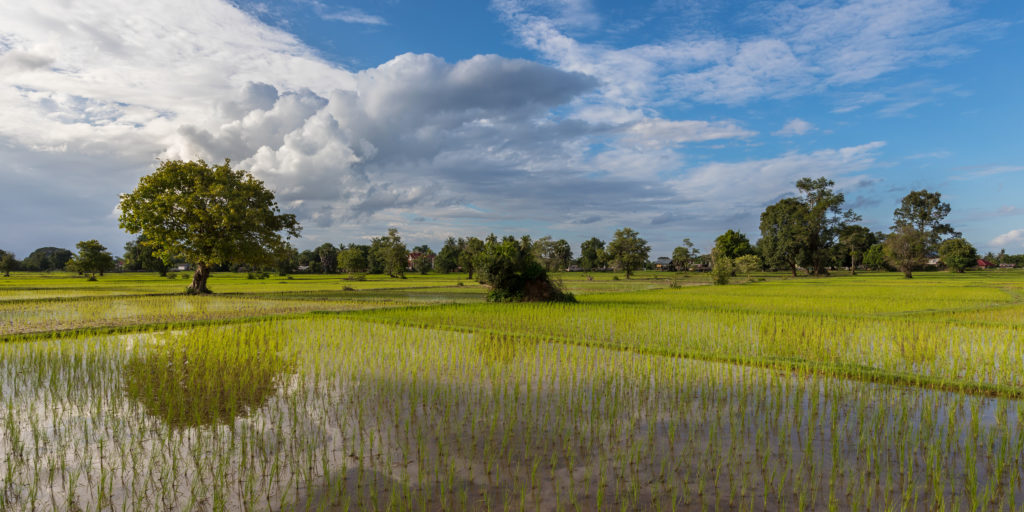So far, climate change hasn’t offered us a pretty picture of the future. Water scarcity, extreme heat, rising oceans—there isn’t much cheer in the voice of scientists as they describe our planet at 900 parts per million (ppm) CO2, an atmospheric measure of carbon dioxide that is over double today’s concentration. According to some scientists, the world is slated to hit this value by 2100.
At least we’ll be able to grow more plants, claim some climate optimists. As higher latitudes get warmer, we may be able to cultivate foods in places that were once inhospitable to agriculture. And maybe our northern and southern forests will get lusher, too.
But that is a bit too simplistic. Plant productivity isn’t regulated by temperature alone. What about carbon dioxide? Nutrient profiles in the soil? Soil moisture? Contrary to intuition, climate change is likely to have a net negative effect on plant production. Agriculture will decline. Other plants will draw down less CO2. Food crops will even become less nutritious.
Scientists are pretty certain of all these negative effects—climate change is decidedly a bad thing for plants. What they are still investigating are the exact mechanisms behind these changes. Some discoveries have been quite surprising.
Diminishing Returns
One such study was published this October by researchers at the University of Washington. To find out how elevated levels of CO2 might affect plant physiology, they grew staple crops like wheat and potatoes in conditions of 710 ppm CO2, which is much higher than modern levels of 410ppm. They found that in response to the high-CO2 conditions, plants thickened their leaves by as much as a third.
Since photosynthesis converts carbon dioxide to biomass, this might seem unsurprising. But according to the UW team, this changes the surface area-mass ratio of the leaves, altering photosynthesis and sugar storage. In the end, it makes plants a less effective carbon sink.
Even without an altered surface area-mass ratio, rising levels of CO2 bode badly for plant productivity. Beyond the UW research, a number of studies show that there’s a natural limit to plants’ CO2 uptake: when you increase carbon dioxide concentrations, there comes a point when plants simply can’t photosynthesize fast enough.
At moderate increases in carbon dioxide concentrations, and under warmer climates, plants may be able to take in more carbon. But not forever. According to research published this fall from Michigan State University, CO2 uptake gradually diminishes as atmospheric concentrations rise.
“We know that there are diminishing returns as you increase CO2,” explained Tom Sharkey, Michigan State University Distinguished Professor and author of the study, in an interview with the HPR.
In his paper published in the journal Environmental Research Letters, Sharkey showed that as the air saturates with carbon dioxide, plant uptake becomes less and less efficient. That is, even as plants grow in size, their ability to draw down CO2 may not follow. This might come as a surprise, since carbon dioxide is a key driver of photosynthesis; plants need it to grow.
“How can something that is in effect a fertilizer also be a pollutant?” said Sharkey, voicing the confusion of many who observe this physiological phenomenon.
According to Sharkey’s study, plant mass will soak up less and less carbon dioxide as carbon dioxide increases. In the study, researchers looked at a process called triose phosphate utilization. When plants take in carbon dioxide, the carbon becomes triose phosphate, and the triose phosphate is later converted into sugar.
What they found was a limitation in this process. Under conditions of high CO2, plants simply couldn’t convert handle any more triose phosphate than a given natural limit, so they stopped absorbing carbon dioxide. Some plants even absorbed less CO2 than when the gas was scarcer in the atmosphere.
These findings have alarmed researchers, and for good reason: current climate models take into account factors like ocean cycles, atmospheric conditions, and ice melt, but it’s often harder to quantify biological effects.
Climate Effects
The Michigan State University researchers estimated that triose phosphate utilization limitation could leave nine gigatons of carbon in the atmosphere by 2100, instead of being sequestered in plants. For context, that’s more weight than a hundred million elephants. And it is over a quarter of the total amount of CO2 all of humanity is putting into the atmosphere every year.
At the University of Washington, researchers predicted that plant thickness alone could account for an extra .3-1.4 degree Celsius rise in temperature by the end of the century. That is on top of what was already expected from the usual suspects of climate change.
Paradoxically, this research shows that CO2—at times both fertilizer and pollutant—can still fall squarely in the pollutant category. If we continue to dump CO2 into the atmosphere, even the “lungs” of the earth won’t be able to keep pace. CO2 rise will happen more quickly than expected, and plants will be less capable of tempering it. We’ve taken the carbon-offsetting powers of plants for granted—in the future, that may no longer be possible.
Despite a promising Paris Agreement, we still face significant barriers to combating climate change. Between an apathetic US and a new Brazilian regime that is considering withdrawing from the Paris Agreement, hope is hard to come by. Even if scientists incorporate these biological factors into their climate models, it is unclear that this will motivate meaningful action on the part of governments. But if triose phosphate utilization limitation is as serious as research suggests, we may need to seriously rethink existing plans to fight climate change simply by planting more greenery.
Image Credit: Wikimedia Commons/ Basile Morin
